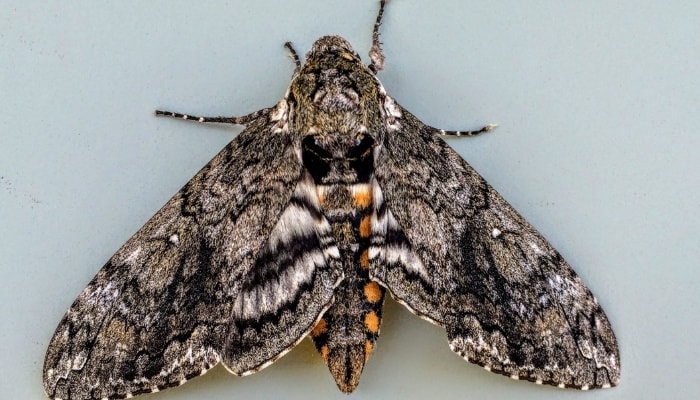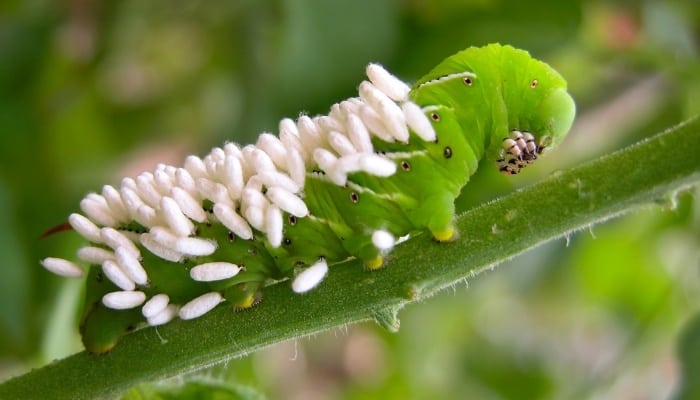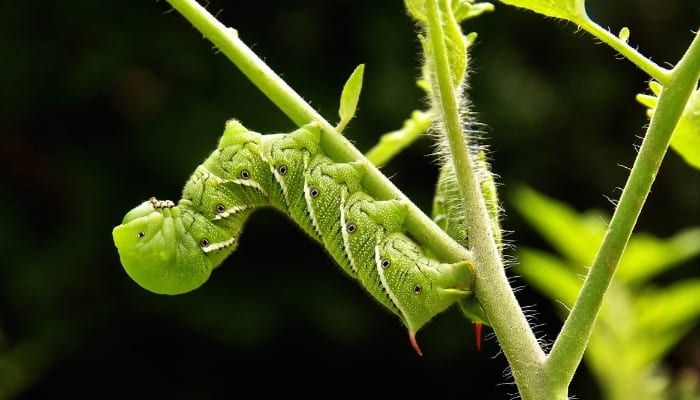The tomato hornwalk is a common pest in gardens and farms that host tomato plants.
Once it turns into the five-spotted hawkmoth, it leaves the tomatoes and flies to other pastures, but until that happens, your tomatoes are at risk.
Are tomato hornworms poisonous? Tomato hornworms are not poisonous to touch, and they do not bite or sting. However, since they consume toxins from the tomato plant, which is a member of the nightshade family, they may accumulate enough toxins over time to make them mildly toxic if ingested.
Nobody likes to see their tomato plants turned into skeletons by the voracious appetites of tomato hornworms.
Read more to understand tomato hornworms, how to identify them, and how to get rid of these pests.
Tomato Hornworms – What To Know
Tomato hornworms have different names throughout the different phases of their lives. Each name implies danger but that couldn’t be further from the truth.
It’s a caterpillar with fierce looks that don’t reflect its almost benign nature.
Tomato Hornworm Identification
Tomato hornworms are large caterpillars with distinct marks and features that make them easy to identify. They have v-shaped marks on each side that point toward their head.
The most distinguishing feature is the curved reddish-black horn on the tail.
They’re different from tobacco hornworms that have diagonal marks on their backs and a red horn on the rear, but both caterpillars grow into similar large moths.
Tomato Hornworm Poop
It’s sometimes hard to identify the tomato hornworm as it blends into the leaves of the tomato plant and becomes indistinguishable from the green background.
The only ways to tell that a caterpillar is hiding on the plant is from the tremendous amount of damage and the trail of black or dark green droppings it leaves in its wake.
Follow that trail, and it will lead you to the feeding caterpillar.
What Do Hornworms Eat?
Hornworms feed on green leaves. They prefer tomato and tobacco plants, but they can also be found feeding on potato, pepper, and eggplant leaves.
Only in rare cases would they feed on weeds like jimson weed and horsenettle. People who keep hornworms as pets feed them leafy greens such as spinach and broccoli leaves.
Tomato Hornworm Damage
The tomato hornworm has little time to fatten up before it turns into a moth. The caterpillar spends most of that time feeding. It can go through the leaves of a whole tomato plant in a single day.
Without the leaves, the plant cannot photosynthesize the light and turn it into energy. This leads to a stunted tomato plant that will wilt and die.
Can You Touch a Tomato Hornworm?
If you touch a tomato hornworm, the caterpillar may try to wiggle from under your touch and scurry to the nearest hiding place, but most likely, it will freeze in hope that you won’t notice it.
The scary-looking spine is simply for intimidation purposes and is completely harmless.
Do Tomato Hornworms Bite? Sting?
The teeth of the tomato hornworms are tiny and are only used to chew on the leaves of the plants. The caterpillar doesn’t use its teeth to attack or defend itself.
As for its famous curved horn, it’s just for show. It’s not a stinger, and the hornworm doesn’t sting.
Its only defense mechanism is to hide and blend into the background of the plant it’s living on. This might explain why some people raise tomato hornworms as pets.
What Do Tomato Hornworms Turn Into?
Tomato hornworms turn into a large moth known as the five-spotted hawkmoth with four brown wings and drab markings. The marking colors range from gray to pink, gold, and brown.
The wingspan of the mature moth is 5 inches wide. From afar, they’re easily mistaken for hummingbirds especially since they hover over the flowers without actually landing on them to feed on the nectar.

Where Do Tomato Hornworms Come From?
The life of the tomato hornworm starts when a mature female hawkmoth lays eggs. Once the eggs hatch, the caterpillar crawls out looking for the nearest tomato or tobacco plant.
It starts feeding nonstop until it reaches 4 inches long. When the caterpillar is ready to pupate, it leaves the plant and goes to the soil.
The next time you see it, it will be a large moth ready to mate and lay eggs.
Are Tomato Hornworms Poisonous To Dogs?
Over time, toxins from the tomato plant may build up in the tomato hornworm’s body, making it mildly toxic if consumed.
The odds of your dog finding a hornworm and consuming it are low as tomato hornworms typically are found on the upper half of plants, and dogs would naturally be off-put by the taste.
Should I Kill Tomato Hornworms?
Tomato hornworms are pests that cause a lot of damage to the tomato plants and ruin the harvest.
Unless you grow a tomato hornworm at home as a pet, you should kill every tomato hornworm you see in the tomato patch.
Sometimes parasitic wasps will lay their eggs on the backs of the tomato hornworms. When the eggs hatch, the wasps will feed on the caterpillars.
Any tomato hornworms found with these white eggs along their backs should be left to increase the number of predator wasps and decrease the number of hornworms.

Tomato Hornworm Natural Predators
Tomato hornworms are notoriously good at hiding and camouflaging. Luckily there are natural predators that can track the caterpillars even into their hiding places and feed on them.
These include ladybugs, lacewings, common wasps, and braconid wasps. Parasitic wasps also lay their eggs right on the caterpillars, and when the eggs hatch, the caterpillar will become a ready meal.
How To Get Rid of Tomato Hornworms
Understanding the lifecycle and habits of tomato hornworms can help you find the best ways to get rid of them. Here are a few recommendations.
- Till the soil to kill the overwintering caterpillars during the pupating phase.
- Follow the dark trails, locate the caterpillar on the tomato plant and dispose of them by drowning them in a bucket full of soapy water.
- Plant companion plants such as parsley, yarrow, and dill.
- Attract predators like ladybugs and lacewings to the garden.
- Spray the plants with a cayenne pepper spray.
Tomato Hornworm Prevention
The best way to prevent tomato hornworms is to disrupt their lifecycle during the pupating phase.
In the winter, the caterpillars turn into yellow-brown pupae that overwinter in the soil. Tilling the soil will kill the pupae and control the spread of the moths that lay eggs.
You should also rotate the crops so that the caterpillars can’t find tomato plants to feed on.
Tomato Hornworm vs. Tobacco Hornworm
Tomato hornworms are caterpillars with v-shaped marks on their sides and a curved reddish-black horn on the rear. Tobacco hornworms have diagonal marks and a red horn.
Tomato hornworms live and feed on tomato plants while tobacco hornworms feed on tobacco plants.
Conclusion
Tomato hornworms are large caterpillars that cause massive damage to tomato plants. While they can’t hurt you (unless you decide to snack on a few), they can strip a tomato plant bare within a day or so.
Don’t hesitate to snatch them off the plant and destroy them. They are not an endangered species, and your tomatoes will thank you!

